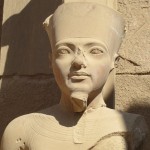 We leave Temple Dush and drive back to the main road through the village of Baris. At the police checkpoint at the intersection we are kindly greeted. They had already recorded information about us when we passed there the night before, so after we have confirmed that we will directly go to Luxor today, they wave us through. It is Friday, the rest day for Muslims, and therefore very quiet on the road. Apart from a number of trucks we see almost no other traffic. The town of Baghdad is the last oasis on the route and after the police checkpoint there, we do not pass any other villages or checkpoints any more. On both sides of the road we only see a golden sand sea. There is a strong wind and we can only just keep our light motorbikes straight.
We leave Temple Dush and drive back to the main road through the village of Baris. At the police checkpoint at the intersection we are kindly greeted. They had already recorded information about us when we passed there the night before, so after we have confirmed that we will directly go to Luxor today, they wave us through. It is Friday, the rest day for Muslims, and therefore very quiet on the road. Apart from a number of trucks we see almost no other traffic. The town of Baghdad is the last oasis on the route and after the police checkpoint there, we do not pass any other villages or checkpoints any more. On both sides of the road we only see a golden sand sea. There is a strong wind and we can only just keep our light motorbikes straight.
At the beginning of the afternoon we see a city looming in the distance. The end of the desert is in sight, we are approaching the Nile. From one moment to the other we drive along green fields, meadows with cows and fields of sugar cane. The transition from the dry desert to the green fields is very abrupt, as if a line is drawn in the landscape with a ruler. We drive along a canal towards Luxor. It is busy on the road. Most cars and donkey carts we pass are loaded with sugar canes. The canes are loaded on wagons that are waiting on a railway track that runs parallel to the road.
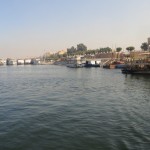 After we have driven along the canal for some time, we turn right and drive up a high bridge to cross the Nile. The river is extremely wide and has a strong current. Along the side of the river cruise ships are waiting for tourists to take a Nile cruise. We enter Luxor and immediately notice how clean it is. For the first time we see street sweepers that sweep all the trash into a green bin with a big broom. We drive through a ’green corridor’ with oleanders and tall palm trees on both sides of the road. A big difference with the dusty roads in the desert and oases.
After we have driven along the canal for some time, we turn right and drive up a high bridge to cross the Nile. The river is extremely wide and has a strong current. Along the side of the river cruise ships are waiting for tourists to take a Nile cruise. We enter Luxor and immediately notice how clean it is. For the first time we see street sweepers that sweep all the trash into a green bin with a big broom. We drive through a ’green corridor’ with oleanders and tall palm trees on both sides of the road. A big difference with the dusty roads in the desert and oases.
We can camp in the middle of Luxor at Rezeiky Camp. In the past the site was often visited by overlanders, but now we are the only guests. On the advice of John and Ruthi (the overlanders we met in the Egyptian desert) we eat at the restaurant of the camp site that evening and enjoy a delicious stew and our first beer since Italy.
After the quiet nights in the desert, we have to get used to the sounds of the city again. We hear cars honking until late at night and early next morning the call to prayer blares loudly throughout the city. The rooster and the dogs at the camp site are also making a lot of noise that morning. The dogs, a mother of three young pups, are playing on the camp site and running round the tent at high speed. At some point I hear a strange noise and then someone next to me cursing heartily. One of the puppies has ran into a line of the tent at full speed, leaving a huge crack in the canvas. If it then appears that the toilet does not flush and there is no water in the shower, we are a bid fed up. A rough start after a short night. Only after a strong cup of coffee and some pastries we let the broken tent for what it is and head into town to visit the Valley of the Kings.
 With the sun in our faces, we walk to the ferry that takes us to the west side of the Nile. We buy a ticket for the ferry and find a place on the upper deck. It is hazy and we can hardly see the other side of the river. When we are still on the ferry we are approached by a taxi driver. He offers to drive us around Luxor to visit different sites that day for a fixed price. He speaks good English and shows a notebook in which where several tourists have written nice comments about him. Clever marketing and it works, because after we have negotiated about the prices we agree that he will be our driver that day.
With the sun in our faces, we walk to the ferry that takes us to the west side of the Nile. We buy a ticket for the ferry and find a place on the upper deck. It is hazy and we can hardly see the other side of the river. When we are still on the ferry we are approached by a taxi driver. He offers to drive us around Luxor to visit different sites that day for a fixed price. He speaks good English and shows a notebook in which where several tourists have written nice comments about him. Clever marketing and it works, because after we have negotiated about the prices we agree that he will be our driver that day.
Once on the other side, an old Peugeot from the 70s stops in front of us and we are introduced to the cousin of the marketeer. As we get in the car it becomes clear that his cousin will actually by our driver, while the smart marketer himself will look for new customers. Not quite what we had agreed, but okay for as long as we safely get where we need to be. In the old Peugeot he takes us to the entrance of the Valley of the Kings. We exchange phone numbers with the cousin so we can call him if we want him to pick us up.
At the entrance to the Valley of the Kings we are approached by a small, slightly older man named Mohammad. He offers to be our guide and gives us his business card. It states that he graduated in 1980 as an Egyptologist and has been working as a guide in Luxor ever since. He already has one customer, a student from South Korea, and for a good price we join him.
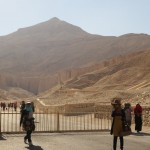 In the Valley of the Kings 63 royal tombs have been found from Pharaohs who lived from 1550 to 1069 BC. The mummies that we saw in the National Museum in Cairo were once buried in their golden sarcophagi in this valley. The tomb of Toetanchamun was also found here, as one of the few tombs with all its treasures. A map of the valley shows how long corridors are carved into the rock to different burial chambers. We visit three tombs and listen to the wonderful stories of Mohammad. He knows a lot about ancient Egypt and tells about the life of the pharaohs, the decoration on the walls, the hieroglyphs and the treasures that were found in the tombs. There are only a few tourists so we have plenty of time to walk around the tombs. It is beautiful and very impressive to see.
In the Valley of the Kings 63 royal tombs have been found from Pharaohs who lived from 1550 to 1069 BC. The mummies that we saw in the National Museum in Cairo were once buried in their golden sarcophagi in this valley. The tomb of Toetanchamun was also found here, as one of the few tombs with all its treasures. A map of the valley shows how long corridors are carved into the rock to different burial chambers. We visit three tombs and listen to the wonderful stories of Mohammad. He knows a lot about ancient Egypt and tells about the life of the pharaohs, the decoration on the walls, the hieroglyphs and the treasures that were found in the tombs. There are only a few tourists so we have plenty of time to walk around the tombs. It is beautiful and very impressive to see.
After three hours we call the cousin and not long after that the old Peugeot stops at the gate. It is time for lunch and we ask him to take us to a local place where we can eat koshary. He grew up in the area and quickly knows where to go. We both order a large plate of koshary and a coke (all for 22 EGP, which is around €2.20).
 On the advice of Mohammad we then visit Habu Temple. The complex consists of several buildings and is still in very good condition. Especially the colours of the hieroglyphs are very well preserved. One of the guards of the complex is trying to make some pocket money by pointing us and all other tourist to the most special hieroglyphs and giving us access to closed areas of the buildings. He barely speaks any English and it seems he makes up most of the stories, but it still allows us to make some nice pictures. When we leave he asks for a contribution for his ’services’. We give him 2EGP, a common amount for services you did not really ask for. He pulls a glum face, gives back the coins and makes clear that he wants to receive more money. Only after I have put the coins back in my pocket and walk away he suddenly agrees to the fee after all.
On the advice of Mohammad we then visit Habu Temple. The complex consists of several buildings and is still in very good condition. Especially the colours of the hieroglyphs are very well preserved. One of the guards of the complex is trying to make some pocket money by pointing us and all other tourist to the most special hieroglyphs and giving us access to closed areas of the buildings. He barely speaks any English and it seems he makes up most of the stories, but it still allows us to make some nice pictures. When we leave he asks for a contribution for his ’services’. We give him 2EGP, a common amount for services you did not really ask for. He pulls a glum face, gives back the coins and makes clear that he wants to receive more money. Only after I have put the coins back in my pocket and walk away he suddenly agrees to the fee after all.
The brown Peugeot is already waiting for us when we leave the temple. The cousin, now again accompanied by the marketer, takes us back to the ferry where we pay them the agreed fee. Even though we had agreed on a fixed price, they both ask for a ’tip’ on top of the price. One can always ask, but we have already paid enough (and probably even too much, as we are not really good negotiators yet). With a clear “NO” it is OK and they wish us a good day.
 Both the actions of the guard at the temple and the question of the taxi drivers are in line with the image we had of Luxor before we came there. We were warned that we would be approached by people who would try to sell us something (a ride in a carriage, a boat trip on the Nile or souvenirs) and would have to negotiate the prices. Especially now that there are fewer tourists in Egypt, the salesmen have to make an effort to get your attention. In some cases, in an unpleasant way. Luckily we did not feel harassed of hassled in any way. While everyone is trying to make some money, most of them stop asking when we tell them friendly but very clear that we do not want to use their services.
Both the actions of the guard at the temple and the question of the taxi drivers are in line with the image we had of Luxor before we came there. We were warned that we would be approached by people who would try to sell us something (a ride in a carriage, a boat trip on the Nile or souvenirs) and would have to negotiate the prices. Especially now that there are fewer tourists in Egypt, the salesmen have to make an effort to get your attention. In some cases, in an unpleasant way. Luckily we did not feel harassed of hassled in any way. While everyone is trying to make some money, most of them stop asking when we tell them friendly but very clear that we do not want to use their services.
On our second day in Luxor we visit Karnak Temple, again with Mohammad as our guide. It is one of the largest temples in the world and very well preserved. Mohammad is already waiting for us at the entrance when we arrive and has already bought tickets for us. We follow him along the beautiful tall columns, the huge obelisks and the many images all morning, while he talks about the history of the temple. Very beautiful.
It is obvious that Mohammed has been around as a guide for a while, because he leaves no question unanswered. He knows all the other guides, who casually say to us that he was their teacher. He also knows the guards of the complex very well, as he takes us to all closed corners of the temple while the guards squeeze a blind eye. A great experience, thanks to a very good guide!
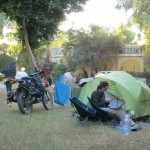 The remainder of the afternoon we spent at the camp site. I work on the blog and cook pasta, while Peter repairs the tent. After a chat with the owner of the camp site about the dogs, the shower and the toilet, he allows us to take a hot shower in one of the rooms of the hotel. A good ending to a great day after all.
The remainder of the afternoon we spent at the camp site. I work on the blog and cook pasta, while Peter repairs the tent. After a chat with the owner of the camp site about the dogs, the shower and the toilet, he allows us to take a hot shower in one of the rooms of the hotel. A good ending to a great day after all.
After three days in Luxor we get on our bikes again and continue our way south. We drive along the Nile to Aswan. A scenic route along the wide river and the green fields there right next to it. Along the way we meet a Chinese cyclist who has been travelling for seven months through the Middle East and Africa. His loaded bicycle stands on the side of the road while he sits in the shade playing his guitar. His name is Zhai Xu Dong, but like many Asians he has an easier western nickname and we can call him Tulsi (Facebook). Like us, he is on his way to Aswan, to take the boat to Sudan. We exchange contact details and agree to try to meet each other in Aswan.
At the end of the afternoon we reach Aswan and we park our bikes at Adam Home Overland Camp (more on this in the next blog post).
Distance travelled until Aswan : 7596 km – 4721 miles
Click here to see the photos in this post.
 PS1 We could not take photos in the tombs in the Valley of the Kings. Fortunately we more than made up for this with (too) many pictures of Habu Temple and Karnak 😉
PS1 We could not take photos in the tombs in the Valley of the Kings. Fortunately we more than made up for this with (too) many pictures of Habu Temple and Karnak 😉
PS2 We are currently in Ethiopia and have already passed through Sudan. However, due to bad internet connections we have not been able to post any updates. We hope to catch up soon.





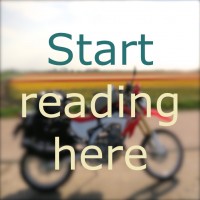


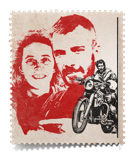
Hallo, leonie en peter. Wat een verschil toch met de westerse wereld. Wat ik wel erg leuk vind om te zien zijn de autos die bij jullie rond rijden. Vooral de oude 504’s van peugeot.echt leuk om te zien voor een peugeot liefhebber zoals ik. Jullie mogen er meer van laten zien van mij. Heel veel plezier met het vervolg van jullie avontuur. Gr Joke en Janleen
Hallo, Leonie en Peter.
Ik heb weer met plezier jullie blog gelezen. Fijn dat alles goed verloopt!
We wensen jullie weer veilige kilometers en wachten op jullie volgende verhalen! Groetjes.
Hoi Peter en Leonie,
ik hoorde deze week van Rob Nieweg over het verslag en de website van jullie.
Heb vanavond alle verslagen met belangstelling gelezen en vind het ontzettend boeiend, zal jullie blijven volgen en wens jullie gezonde reis. Ik zit zelf met Diny in Almerimar onder in Spanje, we overwinteren voor de derde keer dit jaar, heerlijk 8 weken in de zon.
groetjes Herman
Heerlijk weer een update! Soms doe ik net of ik er ook even bij ben, geen probleem om een beeld te krijgen met weer zo’n sprekend verhaal en prachtige plaatjes! Dikke kus
Wat een prachtig verhaal weer! En sinds vandaag meer dan 2000 unieke bezoekers! Die genieten allemaal mee, gefeliciteerd!!
Jeeee! Al in Ethiopië! Jammer dat mijn ouders er niet meet wonen anders had je daar zeker even kunnen verblijven.
Doe voorzichtig in het drukke verkeer daar (met veel overstekend vee) en geniet van jullie trip.
Ik ga nog even wat deadlines halen en andere dingen doen waarvan jullie even verlost zijn
Liefs Michiel
Leuk, een nieuwe update! Ben alweer benieuwd naar alle volgende avonturen. Liefs
Hallo daar, leuk om weer wat te lezen!
Dikke kus xx